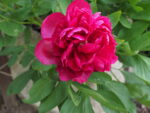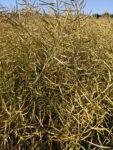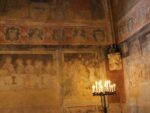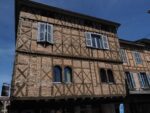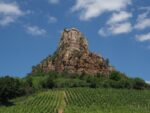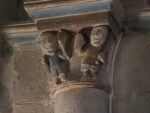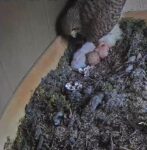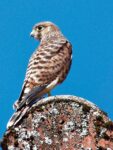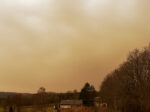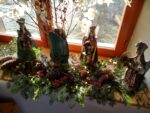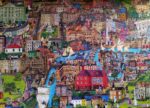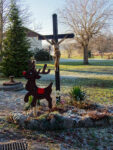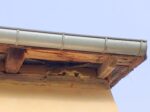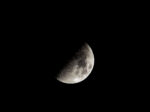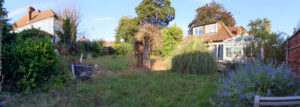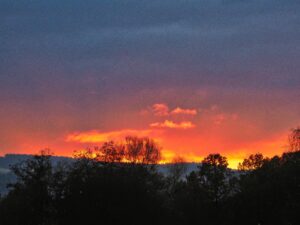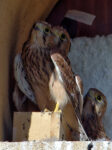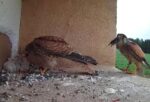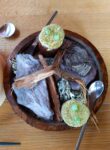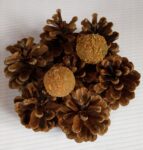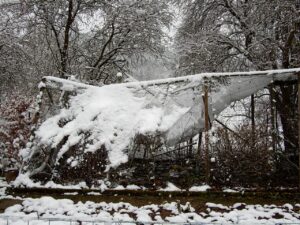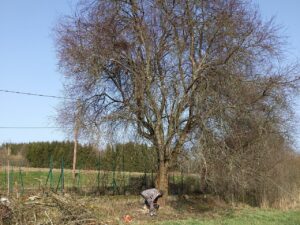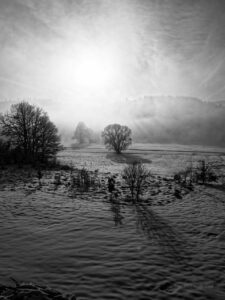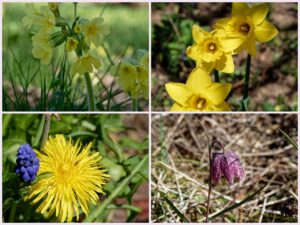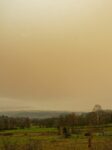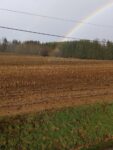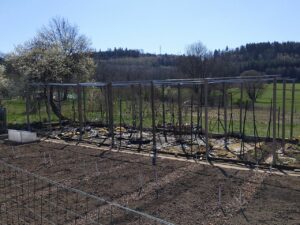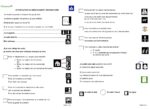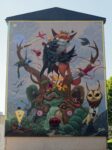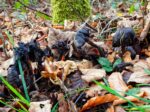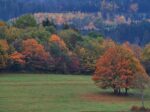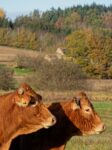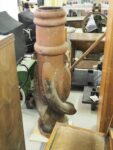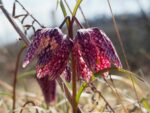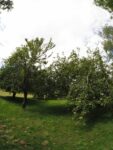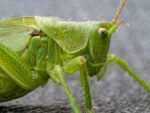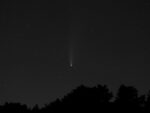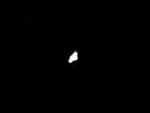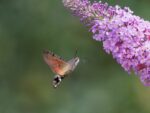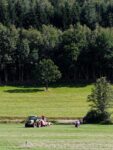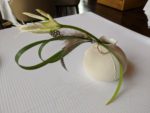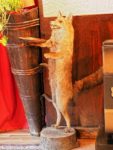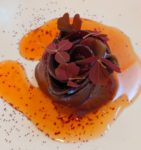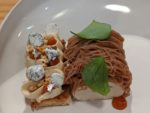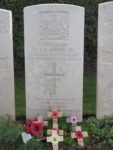To download a printable PDF version (no pictures)
click on this link E2E2022no2d.pdf (five A4 pages)
There are clickable links to additional photographs in the text
At the beginning of May, after a month in Letchworth seeing family and friends, we drove down to Folkestone and the Eurotunnel. Imagine our surprise, after we had boarded the train for France, when we heard a tap on the driver’s window and saw Roger and Dorinda smiling at us. By one of those unlikely co-incidences our Francophile friends (who used to have a holiday home in the next village) had boarded the same shuttle as we had, at the start of one of their French holidays. We arranged to meet up at a service station where we caught up with news and plans in greater comfort over coffee and rolls. They were off to stay in various gîtes, including one outside Mâcon.
Back in Entre-deux-Eaux, John sent off his passport to the chaos of the UK Passport Office, hoping it would eventually emerge renewed in no more than the estimated ten weeks. It felt as if we then spent most of May on medical checks of teeth, eyes and ears. In between, we sorted out a usable part of the potager (the manure still needs to rot down further on most beds), cut the 15″ high grass, sowed onions, broad beans, French beans, courgettes and squash and also cheerful cornflowers, marigolds, candytuft and Sweet Williams seeds in the garden tubs our Letchworth neighbour had given us. The garden was colourful with clematis and peonies.
Our strawberries (including wild ones) were prolific this year. As they do not freeze well (to our taste, at least), John invested in a fruit-and-vegetable dehydrator which gave us dried strawberries with a good flavour. It was also handy when, just before we left for Burgundy, we were offered two kilos of freshly picked cherries from the orchard of the old ferme La Soyotte (one of the organisers of the farm museum lives in the village with our ex-mayor). Amid all this, the twentieth anniversary of our settling in France passed unremarked!
With travel outside France impossible until John received his new passport, we decided to take a short June break in France before the frenzied surge of holidaymakers and the crowded motorways throughout July and August. Who better to consult about comfortable gîtes than frequent-users, Roger and Dorinda. We are fond of Burgundy and they could recommend one of their recent gîtes, La Trélie, to the east of Macon. We booked it for the six days in June that it was still free.
We then unearthed our Michelin Green Guides to Burgundy (from various eras) and popped into one of our supermarkets, Cora, (now open on Sunday mornings, a change since our earlier days here) to get the Green Guide to the Lyons area, which covered the countryside round La Trélie. On the way back, despite the rolling grey rain clouds, we stopped briefly at the village sports field where the annual flea market was gamely taking place, despite the dire forecast. There were a lot of gaps where stallholders had not bothered to turn up, and a hasty walk round did not locate any bargains. Clutching our as yet unopened umbrellas, we met the mayor. “I’ve sent my wife to save places in the food tent. We’ll need to be under shelter shortly.” We reach home before the rain.
It was cool and wet when we organised the trip, but the heatwave began five days later on 11th June, the day we set out. Air-conditioning in cars is such a boon as the temperatures reached 34°C+ outside.
The non-motorway route that we chose took us through the rolling pastures of the Vosges, where elderly gents on tractors were just starting hay making in their small fields, round Vesoul, where we stopped for petrol, coffee, and almond croissants (a weakness of ours, even at lunchtime), over the river Doubs with its dramatic gorge, then wandered cross-country on narrow roads (guided by Waze and white on our ancient Michelin map) towards Mâcon, then turned up an 800 metre rough farm track to a large restored farmhouse in the middle of blonde fields of grain and colza.
We had been sent two lots of contact details for La Trélie, but the old man who answered the phone before we set out either misunderstood or forgot our arrival time. Fortunately one of the owners was in the area seeing to her three hundred and fifty chickens. We later learned that her wealthy family owns all the land and fields around and the house is let to companies during winter as well as tourists in summer. Within five minutes of another phone call, a car disgorged an elegant woman (no sign of chicken feathers or muck) who gave us the key and showed us round the spacious interior: a large open sitting, dining and kitchen area, three bedrooms, shower room and loo. French windows opened onto a roofed terrace and a barbecue building. We would certainly not feel cramped there.
As the weather was so hot, we enjoyed protracted breakfasts in the shade of the terrace, lingering over lunch in different restaurants, and reading or playing games on the cooled terrace in the evenings, and we did not do as much sight-seeing as we usually would.
Our gîte was mid-way between Mâcon (and the vineyard villages of Burgundy) and Bourg-en-Bresse (and farming villages of Ain). On trips to Bourg-en-Bresse, we visited the nearby Royal Monastery of Brou, looked at the elaborate tombs, comic misericords, and art collection in the former monks’ cells, and puzzled over a dramatic “happening” in the courtyard which involved a prowling knight in armour and beautifully crafted puppet props.
In the narrow streets of the old town we enjoyed a risky-sounding but refreshing cocktail of beer, Chardonnay, rhubarb and geranium at the oddly named Scratch restaurant, followed by their menu of the day with its crowning glory of a hazelnut dessert.
How better to finish off an interesting day than with the frescoes in the fourteenth century church in the village of Meillonnas.
Another day we enjoyed strolling round the market town of Châtillon-sur-Chalaronne, with its brick and timber houses, spacious outdoor covered market (empty and echoing that day), and sole surviving gatehouse (where a man on the first floor balcony was assiduously pruning his honeysuckle). We sat down for a coffee outside the basic Café Restaurant de la Poste, then, after watching large plates of food being served to two old men at the table next to ours, ate our way through the menu of the day, finishing with a very good tarte Tatin.
Having dawdled through the rolling fields of ripening cereals of the west of Ain with its Romanesque churches and long, brick and timber farmhouses, some with “saracen” chimneys, our thoughts turned to the vineyards of Burgundy and Beaujolais. As so often on this holiday, we were guided by our stomachs. Roger and Dorinda had recommended the l’O des Vignes in Fuissé, and we thought that, after lunch there, we would climb the nearby Roche de Solutré.
The village of Fuissé lies peacefully among its vineyards, its old washhouse is hung with geraniums rather than scrubbed linen, most of the courtyard buildings are wine producers, as is the Romanesque former church, and a garish circus poster adds colour to the square. The only people in streets in the midday heat were heading to l’O des Vignes, until a truck swerved to a halt and five overalled men leapt out into a shabby building – possibly a rival bar.
After the bright sunlight outside, the bar of L’O des Vignes seemed dim, but the friendly bistrot waiter in his traditional apron led us to a table on their terrace which was shaded by tall trees and busy with locals who seemed to know each other as well as tourists. Behind us lay their more up-market restaurant with its aloof waiters in suits and what looked like untied cravats. The bistrot food was excellent, and we enjoyed the bustle and the informality. (Another day we did try their Michelin-starred restaurant, but preferred the lively bistrot).
Of course, by the time we finished our post-lunch coffee, Helen felt distinctly disinclined to scramble up any rocky promontories in the heat (shame on her when former President Mitterrand climbed it every year between 1946-1995 at Pentecost). Instead she proposed looking at the finds in the Museum of Prehistory at the foot of the Roche de Solutré. The striking escarpment loomed above the vines, disappearing tantalisingly as we drove from Fuissé along the winding narrow roads, then reappearing dramatically. After looking at the finds of animal bones, including a geological layer of compacted horse bones, even John had lost the urge to get to the top of the hill.
Driving carefully down the vineyard roads we passed a car upended in the ditch, with a couple of our age, refusing offers of help and awaiting a tow or lift out. Had they been wine-tasting a little too enthusiastically? The car looked as if it needed something with more power than the small tractors lying idle among the vines.
We did not go wine tasting, though we did look in the old church building in Fuissé to see how it had been converted to wine production, with large barrels in an air conditioned chamber where the altar would once have been. Outside a hosepipe was delivering wine to a large container lorry to be bottled and sold by their client. Seeing the hosepipe was a reminder of holidays in the seventies and eighties when we would take empty bottles into the dingy village wine co-operative to be filled by hosepipe with cheap wine. Ah, those were the days! This time the Beaujolais wine we sipped of an evening on the terrace came from the supermarket.
A contrast with the hot Beaujolais wine villages was the cool interior of the 1733 Hotel Dieu in Belleville-en-Beaujolais where the needy used to be cared for and its elegant apothecary. The original furniture of three small wards has hardly changed and it was still in use until 1991 as a hospice.
Equally cool was the town’s 12th century Eglise de Notre Dame and its interesting capitals.
Back in Entre-deux-Eaux this year’s baby kestrels were growing fast. We mentioned in the last newsletter the “home improvements” which John made in spring to the attic windowsill on which the kestrels had nested last year. They obviously approved of the protective partition and the balcony extension with its raised edge, as the female took up residence while we were in the UK in April, and laid her first egg on 3rd May just before our return. We were able to follow progress remotely thanks to the videos from the cameras/network storage John had installed.
The first egg hatched just before we left for our short Mâcon break. This year all four chicks survived and vociferously demanded food. We watched as they grew and began to lurch and waddle. As the time approached for them to fly, John spent quite a lot of time sitting with his camera in the vegetable patch, next to the compost heap, observing the adults bringing food and the juveniles flapping their wings.
The first one flew early in the morning of 8th July just before we woke. Unlike last year’s trio, it returned occasionally to the ledge to feed and sleep – and perhaps encourage its siblings to test their wings. And over the next few days they have all flown (but occasionally return)! If you haven’t already seen to day-by-day photos and videos, they are on our The return of the kestrels – 2022 website.
Other birds, those greedy ones that somehow find a way into our large fruit cage, are less fascinating as they blunder around unable to find their way out again. However, last week it was Helen who felt trapped in the fruit cage when a button on a pocket on the back of her trousers got caught in the netting. At that moment the mobile phone, which was also in a pocket, rang. Our next-door neighbour, Danielle was offering to bring us some eggs. Since they rebuilt their hen-house, the deep foundations, wire and netting (we used the same for the fruit cage) have protected their hens from theft and murder. Eggs are now plentiful. Helen disentangled herself, phoned John who was doing the weekly shop (“don’t get any eggs!”) and proffered in return some of the blueberries she had been picking. A discussion of crime writers, the library in Saint Leonard, and meeting up to play Scrabble followed. That night’s dinner included poached eggs.
Danielle has been a good addition to the Scrabble players at the Entre-deux-Eaux Oldies’ monthly cards/chat/cake and champagne reunions. At the June session, another of that group, Marie Therese, who lives in the oldest house in the village, brought a cherry clafoutis to celebrate her birthday. And, yes, the cherries from her freezer had come, like ours, from the ferme La Soyotte’s harvest. A few days earlier, we had heard the church bells tolling at length. Sad to say, another of the villagers who had been welcomed us when we bought our house in 1990, had died. He was one of the four farmers who raised cattle and grew crops in the fields around the village. Apart from their house, which is the grandest in the village, he and his wife owned a couple of gîtes. They welcomed us into their kitchen, where we compared notes on letting out properties to holiday makers. He retired some years ago, and had recently been looking very bewildered when he came with his wife to the Oldies sessions. Over our game we recalled this gentle farmer with sadness.
July, and the break-up for summer of local groups, also brought an “end of term” lunch in Taintrux village for Helen’s brain exercise group. The Echauguette restaurant, opposite the mairie, like many now, belongs to the commune, and new managers have recently been installed. The food was typical, with starters of crudités or Vosgesian salad (with breadcrumbs, bacon strips, Munster cheese and poached egg), hearty main courses, plates of cheese and desserts covered in cream, followed by coffees. The star of the show was the Calvados sorbet between courses (wow, was that apple brandy potent!) As ever, it was a noisy, lively affair, also fuelled by the kir aperitifs and carafes of rose wine. It was a surprise to discover that one of the group had been in Fuissé for a family celebration around the time we were there – how surprised we would have been to meet. After the meal we drove to Ghislaine and her husband’s house on the edge of the commune and stood around their vegetable patch admiring it (presumably it would have been too intimate to have been invited indoors).
Our favourite restaurant, l’Imprimerie in the book village is also one that is owned by its commune, we learned recently. But they aim for less hearty fare, offering a menu of the day and two surprise menus of seasonal ingredients, accompanied by unusual and mainly organic wines. With eight small courses, we rarely have room for a cheese course. “Do you not like cheese?” the waiter asked during our July meal there. We confessed that we had in fact indulged in a cheese platter the previous month, when he was not there. He looked unconvinced until John showed him a photo. “Ah,” he sighed, “that would have been the day of my father’s funeral.” He surprised us at the end by producing the dockets listing the dishes we, and other regular customers, had sampled over recent years. What an archive. No wonder we never have exactly the same dishes twice and rarely the same wines.
Much of the décor of l’Imprimerie relates to printing and books. Les Innocents is a restaurant in Strasbourg that we have only been to once before, but a July medical check-up gave us a good excuse to return. For some reason, the décor there aims to recapture the ambience of the thirties and prohibition, with sepia photos of 1920s Australian gangsters and the wine bottles imprisoned behind metal bars. Even the photos of the chefs recall Chicago gangsters with their hats pulled low over their eyes (these were the same chefs who opened Coté Lac in Schiltigheim, some of you may remember from the past?) We again enjoyed our lunch there, served by an efficient, friendly waitress, who was, thankfully, not disguised as a gangster. Afterwards we strolled down to the protestant Saint-Pierre-le-Jeune church to see its striking frescoes which are being restored in a ten-year project.
We try to avoid indulging in too many delicious patisseries here, but were tempted to stop one morning after another appointment for coffees and a lime tart or chocolate confection. What an idyllic image, as beloved of birthday cards, of a patisserie, tables, parasols and the odd bicycle, only slightly marred by the strong smell of fish from the establishment next door.
Thus began our twenty first summer of retirement in E2E, with its long, hot days (did we also mention the hailstorms with hail the size of golf balls and the multiple warning e-mails from insurers to park cars inside and, later, how, if necessary, to make a claim?), leisurely travel, kestrel watching, restaurant lunches and the occasional cake.
How did the cattle, which had been grazing peacefully in the fields all day, and the kestrels now perching somewhere in the trees, cope when this rural tranquillity was disrupted on the evening of 13th July? As it got dark and we walked down to the parking area round the village shop and café, we could hear the loud music and had to stand aside for cars from outside the village nosing up our small road in search of parking spaces. It was time to celebrate the storming of the Bastille once more. All the village children and young people must have been there, some dancing, others sliding between the teeth of an inflatable monster, while their elders sat at tables with drinks. Torches flashed in the field as men checked their fireworks. Then, around 10.45pm, bang! A stunningly loud volley as flashes of light shot into the sky and cascaded down. The lights went out, the music and dancing stopped, and everyone dashed to the edge of the field. What a racket! And then it was all over for a year. Liberte, egalite, fraternite and all that.
Should we wish to escape briefly from la Republique, John’s passport has now arrived, so, despite the increasing Covid cases everywhere, a summer UK visit is now feasible.
Additional photographs
A short stay between and Bourg-en-Bresse and Mâcon
Royal Monastery of Brou
The return of the kestrels – 2022

